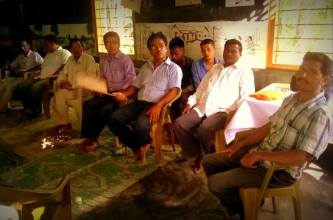Pond before clean-up
According to government figures, Titabor block in Jorhat district is one of the most arsenic affected blocks in Assam. I have started my engagement in two villages of Titabor block, these are Potiya and Kochari village. The approximate population of Potiya is 1500 and Kochari village is 3000 respectively. My justification for choosing them for intervention is chiefly because these two villages do not receive piped water supply from PHED and thereby are dependent on water from tube-wells (handpump). Also, a lot of residents of these villages complain of stomach ache and skin diseases. I visited the households in these villages and came across many cases of skin rashes, which I suspect to be due to Arsenicosis, but I am not wholly sure about it. In my own capacity, I am trying to motivate the people in these two villages to use surface water instead of water from tube wells hoping that would be one solution as surface water has been found to be free of arsenic and other metallic contaminants.

Many households in these villages have ponds of their own but they are not in use as they heavily rely on water from tube-wells. I am trying to advocate the benefits of drinking surface water and the ill effects of drinking water drawn from deep tube-wells especially in cases such as this where the groundwater is arsenic contaminated. I am also talking about the advantages of filtering water before drinking. I am demonstrating to them how to use earthen filters in the villages.
I have also installed water filters to treat the water collected from ponds in the school where I work. The school children are more than happy to use this filtered water. Currently the residents of the two villages through their own efforts are laying pipes in order to connect to the water pipeline that runs through neighboring villages.
Piped water supplied by Public Health Engineering Department (PHED) is properly treated and the community has accepted its benefits. But explaining to them about the presence of arsenic in groundwater and advocating that using water from tube-wells could be a reason for their stomach aches or skin rashes has become a little challenging. This is may be because we are in a stage where we cannot say confidently that these are arsenicosis symptoms, as we do not have proper medical proof of it.
About the Author: Ananta Khanikar is a Community Volunteer and a School Headmaster based in Titabor, Jorhat, Assam. He has been actively trying to increase awareness and joint action at the community level on safe drinking water.


Comments
Post a Comment